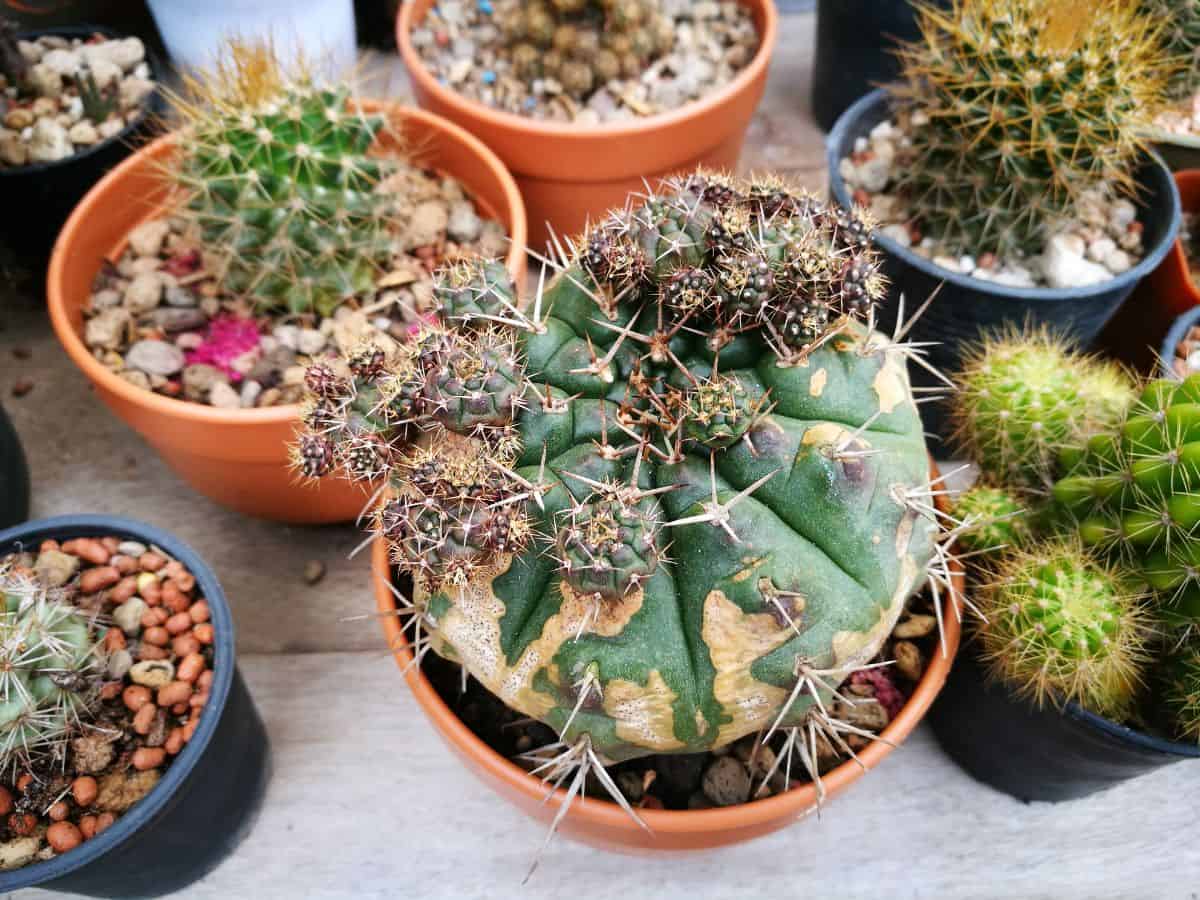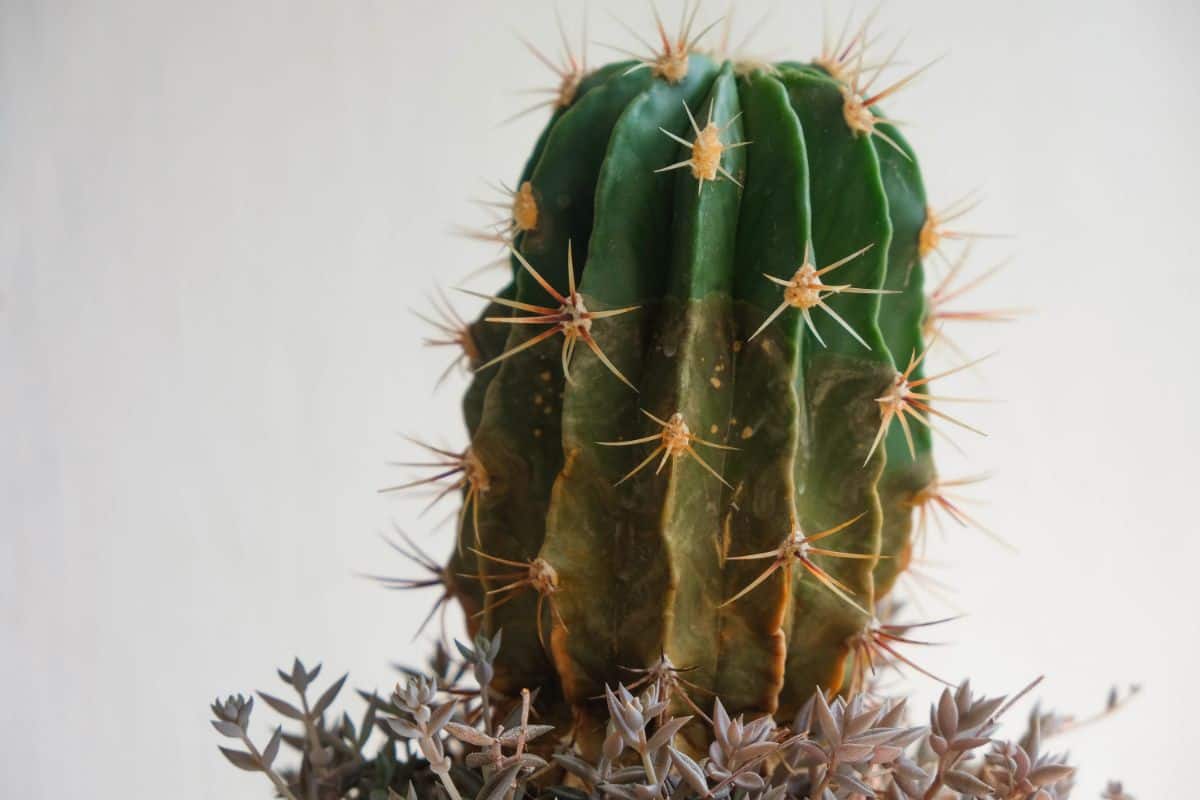If you’re new to the wonderful world of cacti, it can be alarming when parts of your beloved cactus begin to turn brown. Are these brown areas a disease? Fungus? Curable or deadly? If the brown spots on cactus are limited to the base of the plant, you may be looking at cactus corking. Some gardeners find corking to be quite unattractive, but it’s actually just a normal part of the aging process for cacti.
Related Article: How to Plant a Cactus
What Does Cactus Corking Look Like?

Corking begins at the base of the cacti. You may notice your cactus go from vibrant green to dull brown and almost dead-looking. Corking is a relatively slow process, so if discoloration appears suddenly, your cactus may not be corking after all. As corking progresses, the texture of this area of the plant can start to resemble the bark of a tree.
Corking progresses up from the bottom of the plant, from the soil level upwards and usually fairly evenly around the base. This is not to say that you will have a perfect ring of corking around the base of your cactus, but corking doesn’t generally occur in patches or on just one side of the plant. If you notice brown spots further up the plant, toward the top, or only in certain spots, your cactus may not be corking, and you may be looking at a problem.
Depending on the age of the cactus, corking may progress quite a way up from the base. Not all cacti will develop the same amount of corking. Some plants may have just a few inches above the soil line, while particularly large cacti can have several feet of corking around their base.
No products found.
Sunburn can sometimes be mistaken for corking, so if you’ve dramatically increased your cacti’s sun exposure recently, it may have been burned. Although many species of cacti thrive in full sun, it’s important to introduce it to them slowly. This is especially true for plants that have been raised in greenhouses or have been kept inside for the winter. Typically, sunburn appears as patches of brown that can appear on any part of the plant, not just the base.
It’s a good idea to check to the firmness of any discoloration at the base of your cactus. If it seems firm or hard when you apply gentle pressure, your cactus is corking. Similar to the bark of a tree, corking should not give in when you press on it. However, if the plant seems soft or squishy, it’s more likely that the plant is rotting.
Check Also: Best Cities in Arizona for Succulent and Cacti Lovers
What Causes Corking?

As cacti age and grow, they can become somewhat top heavy, which puts them at risk of breaking or falling over. Since cacti are capable of containing vast reserves of moisture, they can be quite heavy. This weight can be detrimental to the plant if its stem isn’t strong enough to support the weight of the rest of the plant.
To prevent permanent damage from breakage, as cacti grow, they begin corking to help provide stability to the base of the plant. As the corking progresses up the base of the plant, the fibers harden to support the plant so that it can continue to expand upwards and outwards.
Check Also: The Best Cities in California for Succulent Lovers
As most cacti are not fast-growing plants, you may have a plant for many years before you notice any corking. It can take quite a long time for some species to grow large enough to require the extra support of a hardened base.
However, there is no exact age at which you can expect your cactus to begin corking. Some cacti may exhibit brown, hardened areas around the base fairly early, while others may grow so large that they appear to be at risk of breaking before you notice any corking. Some cacti may never grow large enough to require the additional support of hardened tissue. Not all species of cacti are prone to corking.
Although the main cause of corking is the aging process, a plant’s environment may have some impact on when corking begins. Some gardeners have noticed that plants exposed to harsher light levels and temperatures sometimes develop more corking than those in less extreme conditions, but there is no specific trigger that causes this process to begin.
Is Corking Harmful?
Although corking may not be the most attractive feature of cacti, it’s a completely natural occurrence and will not cause any harm to your plant. It is a normal part of aging, and unfortunately, as with our own aging, it cannot be prevented.
As unsightly as corking may be, there is no “treatment” that can stop or slow down the process. Unfortunately, you just have to accept this new and interesting characteristic on your cactus. Remember, each plant is an individual and as such they may have many different marks or scars that make them unique. Corking is simply a sign that your cactus has lived long enough and grown large enough to require a little extra support.
If you absolutely can't stand the sight of corking, you always have the option of taking a cutting from your cactus and starting fresh. You can take the cutting and propagate it in a different container. You'll be able to enjoy your new cactus for some time before the aging process takes hold. You can either dispose of the older cactus or give it to someone who doesn't mind a little corking at the base of their plants.
So, if you notice discoloration at the base of your cacti, it’s important that you carefully examine the plant to make sure that it is indeed corking, rather than a sign of pests, damage, or disease. Remember, the location, texture, and firmness of the area will help you to determine whether you’re looking at a normal sign of aging, or something more serious. If it does turn out to be corking, take a moment to appreciate your cacti's new, unique characteristic.


Samayla Nahrin
Thanks for the important information you helped me a lot
Patrick Grubbs
Glad to be of service!
Indra
Veey useful.. it's worth sharing.